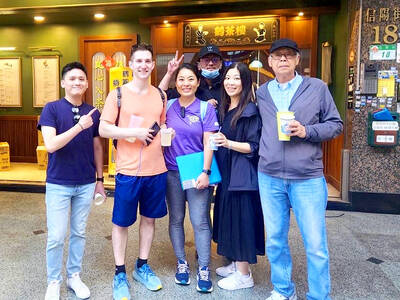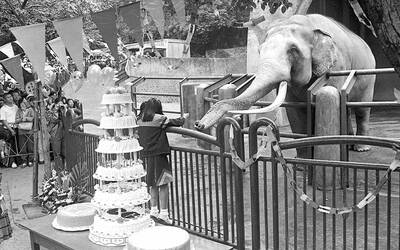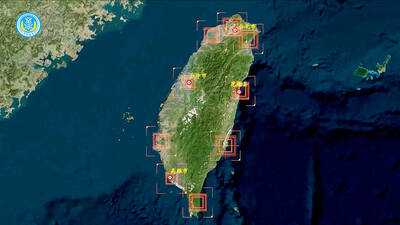Although it has been superceded as the main transport link between Changhua County and Yunlin County, the Hsiluo Bridge has retained its place in the hearts of local residents. The bridge, which was completed in 1952, will be celebrating its 50th anniversary as the center of a cultural festival designed to showcase the tourism potential of two of Taiwan's less high-profile counties.
Started in 1937, when Taiwan was still a Japanese colony, construction of the bridge was delayed by World War II and was only completed with American funding in 1952. At the time, at nearly 2km in length, it was the longest bridge in Asia and served as a major artery of north-south transportation. This role has since been overtaken by the newer expressways, but the bridge remains a powerful symbol of unity -- at least, on this occasion, when the two county governments have got together to throw the biggest party ever for this local engineering monument.
The highlight of the event will be regular displays of martial arts put on by the Yunlin county government -- in what was once a rough and wild area, Yunlin had the reputation of producing the best martial artists -- and copious displays of flowers, for which Changhua is famous. In addition, many other local specialties will be on display, with temporary rice and soy source museums set up on the Yunlin side of the bridge -- both products for which the county is famous.
According to Lin Re-yang (林日揚), head of the Yunlin Tourism Bureau, local enthusiasm for the event has been so great that there have been twice the number of applications for stall space as stalls available.
Last year, official figures for attendance at the Hsiluo Bridge Festival was 300,000 people, but Lin said that with all the additional activities put on for the 50th anniversary, he expected at least 500,000 over the nine-day event this year.
Puppeteer Huang Hai-tai (
The festival is the prelude to a comprehensive revamp of the bridge into a tourist attraction that Lin hopes will bring domestic tourist dollars to both Yunlin and Changhua counties. "We will be spending quite a lot of money putting lighting along the length of the bridge, making it a lovely environment in which people can drink coffee and relax," he said.
While the bridge is still used by pedestrian traffic -- mainly vegetable farmers taking the produce to market -- Lin said that even this function will come to an end in around two years, and there is a proposal at the moment to turn the bridge into a sculpture corridor.
The opening ceremony for the festival will take place between 5pm and 9pm tomorrow along the length of the bridge and there will be events daily through to next Sunday.

A vaccine to fight dementia? It turns out there may already be one — shots that prevent painful shingles also appear to protect aging brains. A new study found shingles vaccination cut older adults’ risk of developing dementia over the next seven years by 20 percent. The research, published Wednesday in the journal Nature, is part of growing understanding about how many factors influence brain health as we age — and what we can do about it. “It’s a very robust finding,” said lead researcher Pascal Geldsetzer of Stanford University. And “women seem to benefit more,” important as they’re at higher risk of

Eric Finkelstein is a world record junkie. The American’s Guinness World Records include the largest flag mosaic made from table tennis balls, the longest table tennis serve and eating at the most Michelin-starred restaurants in 24 hours in New York. Many would probably share the opinion of Finkelstein’s sister when talking about his records: “You’re a lunatic.” But that’s not stopping him from his next big feat, and this time he is teaming up with his wife, Taiwanese native Jackie Cheng (鄭佳祺): visit and purchase a

April 7 to April 13 After spending over two years with the Republic of China (ROC) Army, A-Mei (阿美) boarded a ship in April 1947 bound for Taiwan. But instead of walking on board with his comrades, his roughly 5-tonne body was lifted using a cargo net. He wasn’t the only elephant; A-Lan (阿蘭) and A-Pei (阿沛) were also on board. The trio had been through hell since they’d been captured by the Japanese Army in Myanmar to transport supplies during World War II. The pachyderms were seized by the ROC New 1st Army’s 30th Division in January 1945, serving

The People’s Republic of China (PRC) last week offered us a glimpse of the violence it plans against Taiwan, with two days of blockade drills conducted around the nation and live-fire exercises not far away in the East China Sea. The PRC said it had practiced hitting “simulated targets of key ports and energy facilities.” Taiwan confirmed on Thursday that PRC Coast Guard ships were directed by the its Eastern Theater Command, meaning that they are assumed to be military assets in a confrontation. Because of this, the number of assets available to the PRC navy is far, far bigger